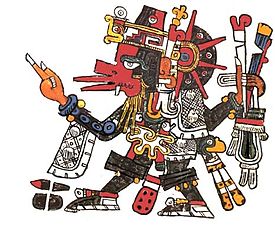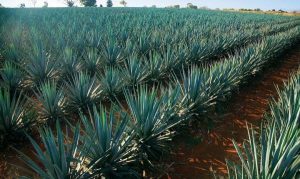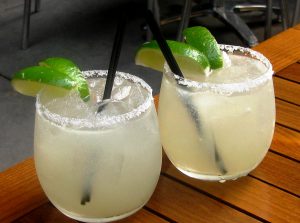
Quetzalcoatl Summoning Tequila
Long ago, in earth earliest days, humans found their world bathed in darkness. The evil goddess Tzintzimitl had consumed the sun and all its light. Quetzalcoatl, the god of redemption and giver of life, was angered by Tzintzimitl’s deed and ascended to the heavens to give battle. While pursuing Tzintzimitl he discovered Mayahuel, her beautiful granddaughter who was being held against her will.
Quetzalcoatl instantly fell in love with Mayahuel and returned to earth with her at his side. This infuriated Tzintzimitl and she searched everywhere for the pair. They were forced to hide and scurry from place to place keeping one step ahead of the evil goddess. Weary of running, Quetzalcoatl determined to disguise himself and Mayahuel as branches on a tree carefully positioned so the breeze would cause the two branches to sweep and caress each other. This scheme was eventually discovered and in a fit a rage Tzintzimitl ripped the branch possessing the soul of Mayahuel from the tree and broke it in to tiny pieces. Devastated, Quetzalcoatl slew Tzintzimitl returning light to this world but his love was gone.
He buried the pieces of the broken branch and drenched the ground in his tears giving life to the first agave plant. Quetzalcoatl drank the plant’s sweet nectar but it gave him little joy until the gods bestowed “special” properties to the agave to comfort Quetzalcoatl’s heart and soul. This, according to Aztec legend, is how the agave came into existence and for thousands of years the natural fermenting nectar of the agave has been used in ceremonies of religious and cultural significance. To this day, Mayahuel is considered by the Aztec people to be the goddess of agave. Today, standing firmly in the 21st century, we still find Tequila, more than any other spirit, to be shrouded in mystery, awe, and occasionally foreboding.

Blue Agave Growing in Mexico
Tequila myths and legends abound in the modern world as well, albeit primarily in the mortal world (although I thought that I died one night in Guadalajara, but that’s another story). Much confusion still surrounds the unique agave plant and Tequila. Is it a cactus? No, actually it belongs to a botanical genus of its own, agavaceae that is closely related to the lily and is indigenous to the Americas, chiefly Mexico. I have read in more than one “source” that Tequila is 2,000 years old.
While agave has provided alcoholic beverages for thousands of years, Tequila is not nearly as old. Tequila is a distilled beverage and this process did not find its way to Mexico until the Spaniards arrived near 1520. Prior to this agave based alcohol was produced naturally, and still is, from the sweet agave sap. This drink is known as pulque and is the unofficial drink of Mexico. I say unofficial, as most pulque is sold from large plastic pails from the back of a pick-up truck in rural Mexico.
Another modern myth suggests that Tequila is simply distilled pulque, which is simply not the case. Pulque is most often produced without harming the agave plant. The leaves and/or flower stalk are “tapped” in order to collect the sweet sap or aguamiel (agave honey), as it is known. In the production of Tequila, the plant is harvested whole after maturing eight to twelve years, cooked in order convert starches to sugars, and crushed to release the sweet liquid which is in turn fermented and then distilled.

Everyone Loves a Margarita
The most commonly heard Tequila myths surround the drinking of Tequila. It is often theorized by nightclub warriors that Tequila is a hallucinogenic. This misconception is likely to have developed out of confusing mezcal with mescaline, a true hallucinogenic, found naturally in the peyote cactus (remember the “Tequila is made from cactus” myth). Mezcal is the broader category of agave-based spirits of which Tequila is a very specific sub-set. All Tequilas are mezcals while the reverse is certainly not true.
Tequila must be made in a designated area lying primarily in the state of Jalisco. Further, Tequila is made exclusively with the “blue agave” (agave azul tequilana weber). No dissertation of Tequila myth is complete without a mention of the worm. For the record, there are no worms in Tequila, no Tequila brand has a worm in the bottom of the bottle. In fact, the strict production and bottling of Tequila forbids such a thing. It is true that some types of Oaxacan mezcal have been bottled with a worm – called a gusano, which is actually a butterfly caterpillar. However, as the quality and image of mezcal improves, this practice has been all but abandoned.
